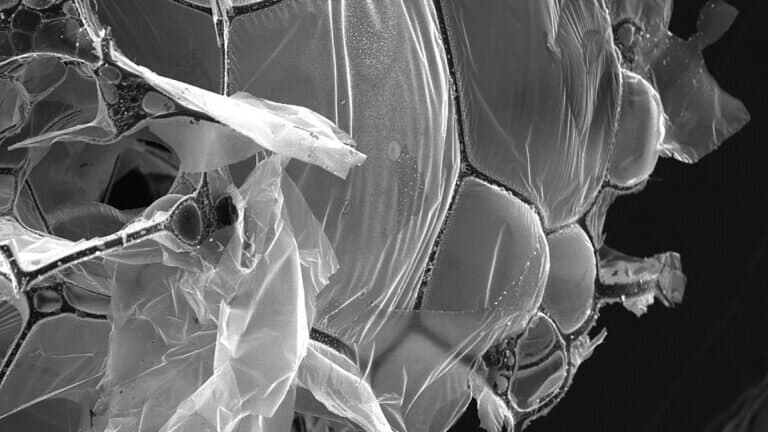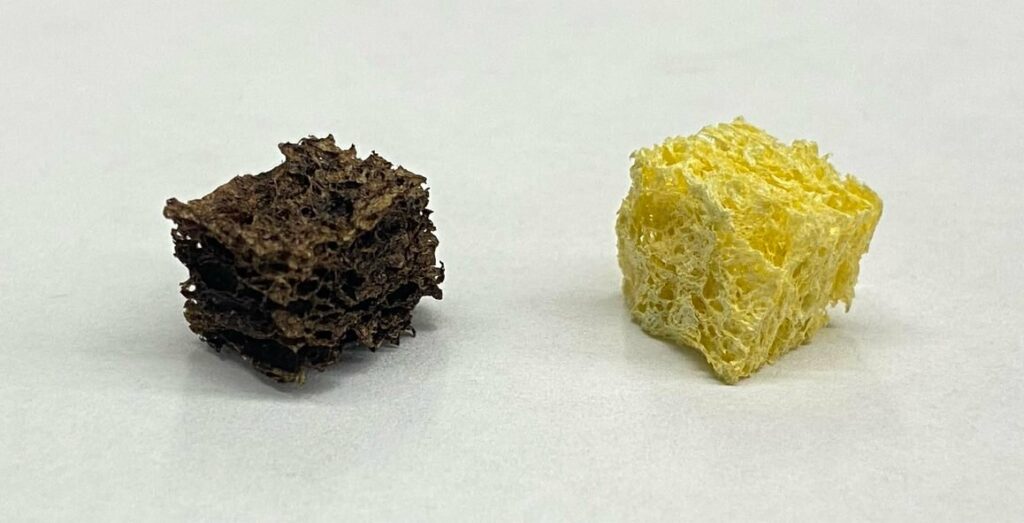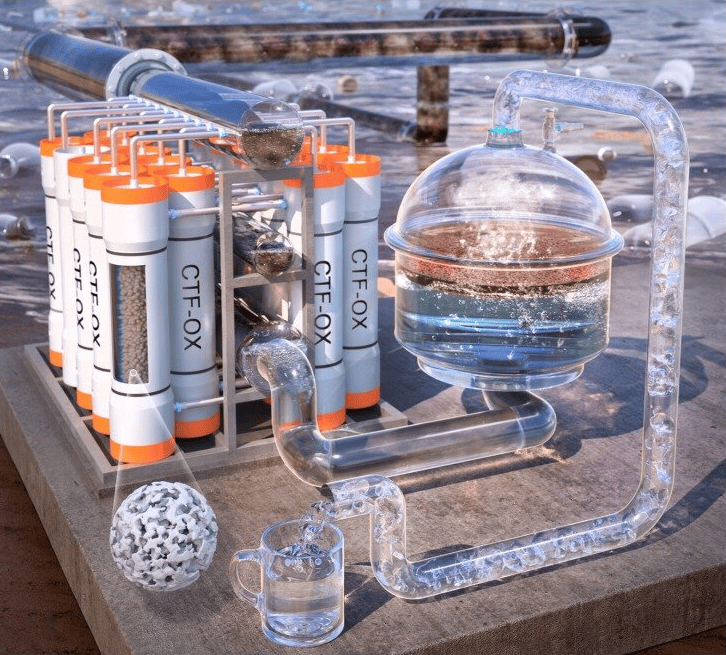
Researchers at Princeton recently unveiled a new material based on egg whites that can filter out microplastics from water.
“I was sitting there, staring at the bread in my sandwich,” recalls Craig Arnold Professor of Mechanical and Aerospace Engineering and vice dean of innovation at Princeton. “And I thought to myself, this is exactly the kind of structure that we need.”
Arnold tasked his research group with developing different ‘bread’ recipes to see if they can filter out microplastics. The ‘bread’ in this case is actually aerogel — porous ultralight material derived from a gel. Initially, the team kept hitting roadblocks as material after material didn’t offer the desired properties. Ultimately, they zoomed in on egg whites.
Egg whites, in addition to being delicious and nutritious, have remarkable properties. If you freeze-dry and heat them enough, in an oxygen-less environment, they create a special type of structure of interconnected strands of carbon fibers and graphene. The team experimented with more and more egg white structures until they found a structure that seemed be just perfect.
“We started with a more complex system,” Arnold said, “and we just kept reducing, reducing, reducing, until we got down to the core of what it was. It was the proteins in the egg whites that were leading to the structures that we needed.”
The water filtration system they built was tested on seawater and was able to filter out over 98% of the salt and microplastics in the water, far better than most existing filters, and with a material that’s cheap and readily available.
The filter couldn’t come at a better time. Studies have shown that microplastics are ubiquitous and we consume them almost every single day. Microplastics aren’t the only problem in water. In fact, the water we drink often contains far more things we want to get rid of.
Cleaning lead

Over half of today’s US population had elevated levels of lead in their blood at some point. Lead contamination is a very serious problem that can affect the nervous system and kidneys, especially in children — which is why it’s so important to keep it out of our water.
“The presence of heavy metals in the water supply is an enormous public health challenge for the entire globe,” said Northwestern’s Vinayak Dravid, senior author of the study and Abraham Harris Professor of Materials Science and Engineering at Northwestern’s McCormick School of Engineering and director of global initiatives at the International Institute for Nanotechnology. “It is a gigaton problem that requires solutions that can be deployed easily, effectively and inexpensively. That’s where our sponge comes in. It can remove the pollution and then be used again and again.”
With that in mind, Northwestern University engineers have developed a new sponge that can remove metals (not just lead) from water. Their water filtration system uses a similar, sponge-like material structure that is coated with nanoparticles that offer an efficient, economic, ecofriendly and reusable alternative to cleaning water.
“You want a material with a high surface area, so there’s more room for the lead ions to stick to it,” said Benjamin Shindel, a Ph.D. student in Dravid’s lab and the paper’s first author. “These nanoparticles have high-surface areas and abundant reactive surface sites for adsorption and are stable, so they can be reused many times.”
Meanwhile, a team from Daegu Gyeongbuk Institute of Science and Technology in South Korea, led by Professor Park Chi-Young, developed yet another porous material that filters water. Specifically, the material filters out both microplastics and phenolic organic contaminants in water at ultra-high speeds.
“The technology we developed here is an unrivaled water purification technology with the world’s highest purification efficiency, removing more than 99.9% of phenolic microplastics and VOC contaminants in water at ultra-high speeds. We expected that it will be a universal technology with high economic efficiency that can purify contaminated water and supply drinking water even in areas where there is no power supply,” said Chi-Young, commenting the study.
We take water for granted

The influx of new water filtration systems comes at a time when water pollution is on the rise. Population growth, intensive agriculture, and industrial activities are all posing extra threats to our water system. While these problems disproportionately affect Asia, Africa, and Latin America, no part of the world is spared. For instance, 22 % of Europe’s surface water bodies and 28 % of the groundwater area are significantly affected by diffuse pollution from agriculture and in the US, water contamination is regarded as the most pressing environmental problem. Pathogen and microplastic pollution are also on the rise, and climate change is posing additional threats to water supply systems.
Researchers emphasize that it’s crucial to be more aware of these challenges, as well as the sustainability concerns that our water consumption raises.
“We need to ask more questions about our water, where that water comes from and how it gets to us,” says Mandy Meriano, associate professor, teaching stream, in the department of physical and environmental sciences at the University of Toronto Scarborough. “Sometimes I think we’re a bit too comfortable in our own comfort.”
It will take some time before these innovative solutions reach your home water filtration systems, but ultimately, these systems can make a difference in ensuring clean water for households around the world, particularly if they are affordable and scalable. At the end of the day, however, we need to start paying attention to how we use water and start taking more sustainable action.









